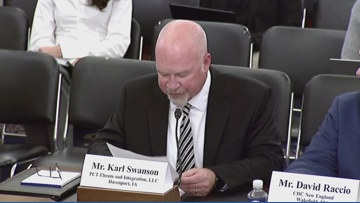Federal Education Policy and its Implications for Sustainable Development Goals
Challenges to SDG 4: Quality Education
Recent directives from the federal administration propose significant budget cuts to the Department of Education. These measures pose a direct threat to the achievement of Sustainable Development Goal 4 (SDG 4), which aims to ensure inclusive and equitable quality education for all. The anticipated consequences of these funding reductions include:
- Disproportionate Impact on Vulnerable Populations: The brunt of the fiscal cuts is expected to be borne by low-income communities, undermining SDG Target 4.5, which calls for equal access to all levels of education for the vulnerable. This action risks widening the educational attainment gap.
- Erosion of Inclusive Curricula: The administration’s call to eliminate Diversity, Equity, and Inclusion (DEI) programs from school services and curricula directly contravenes the principles of SDG Target 4.7. This target emphasizes education for sustainable development, human rights, gender equality, and the appreciation of cultural diversity.
Conflict with SDG 10: Reduced Inequalities
The proposed policies risk exacerbating existing disparities, running counter to SDG 10, which focuses on reducing inequality within and among countries. By targeting resources and programs that support marginalized students, the federal actions could deepen social and economic divisions, hindering progress toward a more equitable society.
The Role of State Constitutions and SDG 16: Peace, Justice and Strong Institutions
A significant legal and institutional conflict is emerging, highlighting the importance of SDG 16, which promotes just, peaceful, and inclusive societies with strong institutions.
- State Constitutional Mandates: Most state constitutions legally require the provision of public education, often stipulating specific quality standards, curricula, and student services. These obligations may directly conflict with federal directives to cut funding and alter educational content.
- Judicial Adjudication: The resolution of these conflicts will likely fall to state and federal courts. These judicial bodies will be tasked with determining whether state law can serve as a bulwark against federal policies perceived as detrimental to the fulfillment of educational mandates, thereby testing the strength and independence of judicial institutions as envisioned in SDG 16.
Expert Analysis and Key Discussion Points
A panel of experts convened to analyze the ramifications of the administration’s actions on the education sector and its alignment with global development goals. The core topics of discussion included:
- The direct effects of federal policy changes on school operations and student services.
- The strategic responses being formulated by schools and state education departments.
- The potential legal pathways and outcomes of court challenges over education policy.
Panel of Experts
- John B. King Jr., Former U.S. Secretary of Education; Chancellor of the State University of New York
- Aaron Saiger, Professor of Law, Fordham University
- Martha Dalton, Journalist, The Atlanta Journal-Constitution
- Moderator: Alicia Bannon, Director, Brennan Center Judiciary Program; Editor in Chief, State Court Report
Which SDGs are addressed or connected to the issues highlighted in the article?
-
SDG 4: Quality Education
The entire article focuses on education policy, including federal funding, school services, curricula, and standards. The proposed cuts to the Department of Education and changes to school programs directly impact the provision of quality education.
-
SDG 10: Reduced Inequalities
The article explicitly states that the “brunt of these cuts will likely fall on low-income communities” and mentions the proposed “elimination of diversity, equity, and inclusion programs.” This directly addresses the theme of inequality in access to resources and opportunities.
-
SDG 16: Peace, Justice and Strong Institutions
The article highlights a conflict between federal policy and state law, noting that “State courts and constitutions stand in the president’s way.” The discussion of how “court fights over education policy may play out” relates to the rule of law, access to justice, and the functioning of accountable institutions.
What specific targets under those SDGs can be identified based on the article’s content?
-
SDG 4: Quality Education
- Target 4.1: By 2030, ensure that all girls and boys complete free, equitable and quality primary and secondary education. The article’s concern over funding cuts and changes to standards directly relates to maintaining equitable and quality education.
- Target 4.5: By 2030, eliminate gender disparities in education and ensure equal access to all levels of education and vocational training for the vulnerable. The focus on cuts affecting “low-income communities” and the elimination of “diversity, equity, and inclusion programs” points directly to this target’s goal of ensuring equal access for vulnerable groups.
- Target 4.a: Build and upgrade education facilities that are child, disability and gender sensitive and provide safe, non-violent, inclusive and effective learning environments for all. The proposed elimination of “diversity, equity, and inclusion programs” is a direct challenge to creating inclusive learning environments.
-
SDG 10: Reduced Inequalities
- Target 10.2: By 2030, empower and promote the social, economic and political inclusion of all, irrespective of… economic or other status. The article addresses this by highlighting policies that would disproportionately harm “low-income communities” and remove programs designed for “diversity, equity, and inclusion.”
- Target 10.3: Ensure equal opportunity and reduce inequalities of outcome, including by eliminating discriminatory laws, policies and practices. The proposed federal policies, such as funding cuts for low-income areas, can be seen as practices that would increase inequalities of outcome in education.
-
SDG 16: Peace, Justice and Strong Institutions
- Target 16.3: Promote the rule of law at the national and sub-national levels and ensure equal access to justice for all. The article discusses the potential for “state and federal judges” to be called upon to resolve conflicts between federal orders and state constitutions, which is a core aspect of the rule of law.
- Target 16.6: Develop effective, accountable and transparent institutions at all levels. The conflict described between the federal administration’s orders and states’ constitutional obligations to provide education is a matter of institutional effectiveness and accountability.
Are there any indicators mentioned or implied in the article that can be used to measure progress towards the identified targets?
The article is focused on policy debate rather than data, but it implies several indicators that could be used to measure progress:
-
For SDG 4 (Quality Education)
- Level of federal education funding: The article centers on President Trump’s order to implement “cuts to the Department of Education and federal education funding.” The amount and allocation of this funding, especially to low-income areas, is a direct indicator.
- Existence of diversity, equity, and inclusion programs: The demand for the “elimination of diversity, equity, and inclusion programs” makes the presence and robustness of such programs a key indicator of an inclusive learning environment (Target 4.a).
- Adherence to state-mandated educational standards: The article mentions that many states “must meet certain standards, teach certain curricula, and provide student services.” Compliance with these standards in the face of conflicting federal policy is an indicator of education quality.
-
For SDG 10 (Reduced Inequalities)
- Disparity in educational resources: The statement that cuts will fall on “low-income communities” implies that the gap in funding and resources between these and other communities is a measurable indicator of inequality.
- Implementation of inclusive policies: The presence or absence of “diversity, equity, and inclusion programs” serves as an indicator of efforts to ensure equal opportunity and promote inclusion (Targets 10.2 and 10.3).
-
For SDG 16 (Peace, Justice and Strong Institutions)
- Number of legal challenges over education policy: The reference to potential “court fights over education policy” suggests that the frequency and nature of such litigation can be an indicator of institutional conflict and the functioning of the rule of law.
- Resolution of federal-state policy conflicts: The article poses the question of whether “state law provides a bulwark against harmful federal policies.” The outcomes of these conflicts in court would indicate the strength and accountability of state-level institutions versus federal ones.
Table of SDGs, Targets, and Indicators
| SDGs | Targets | Indicators (Implied from Article) |
|---|---|---|
| SDG 4: Quality Education |
4.1: Ensure equitable and quality education.
4.5: Ensure equal access for the vulnerable. 4.a: Provide inclusive and effective learning environments. |
– Level of “federal education funding,” particularly for “low-income communities.” – Adherence to state-mandated “standards” and “curricula.” – Existence and implementation of “diversity, equity, and inclusion programs.” |
| SDG 10: Reduced Inequalities |
10.2: Promote social, economic, and political inclusion.
10.3: Ensure equal opportunity and reduce inequalities of outcome. |
– Disparities in educational funding and resources affecting “low-income communities.” – Presence of policies and programs aimed at promoting “diversity, equity, and inclusion.” |
| SDG 16: Peace, Justice and Strong Institutions |
16.3: Promote the rule of law and ensure equal access to justice.
16.6: Develop effective, accountable, and transparent institutions. |
– Number and outcomes of “court fights” between federal and state authorities over education policy. – The ability of “state courts and constitutions” to serve as a check on federal policy, indicating institutional accountability. |
Source: brennancenter.org







